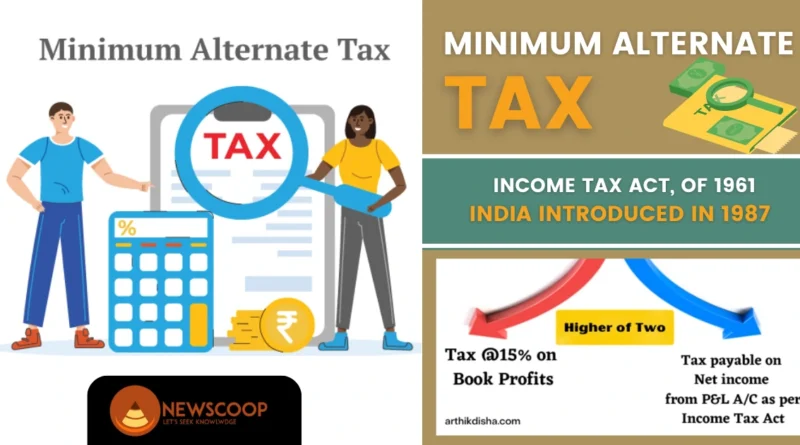Minimum Alternate Tax (MAT): Provision in India
The Indian economy thrives on the contributions made by various entities, including companies. To ensure that companies pay their fair share of taxes, the Indian government has implemented several tax provisions, one of which is the Minimum Alternate Tax (MAT).
In this article, you will get to know about Minimum Alternate Tax (MAT) and its significance in India’s tax landscape. Aspiring candidates preparing for the Union Public Service Commission (UPSC) examinations will gain a comprehensive understanding of MAT, including its purpose, calculation method, and the impact it has on promoting tax compliance and bridging the gap between accounting profits and taxable income.
What is Minimum Alternate Tax (MAT)?
Minimum Alternate Tax (MAT) is a tax provision introduced in India’s Income Tax Act, of 1961. It is designed to ensure that companies, especially those enjoying tax exemptions or deductions, pay a minimum amount of tax. MAT was implemented to prevent the misuse of tax incentives and bridge the gap between accounting profits and taxable income.
Let’s Understand Minimum Alternate Tax (MAT) with an Example
Imagine you have a piggy bank where you save your money. Let’s say you saved ₹100 in your piggy bank. But you have a special rule that says you need to put at least ₹20 in your savings, no matter how much you actually save.
In this case, the ₹20 is like the MAT. It is a minimum amount you have to save, regardless of how much you actually save. So, even if you saved only ₹10, you would still need to put ₹20 in your savings because of the special rule.
Similarly, in the tax system for companies, there is a rule called Minimum Alternate Tax (MAT). It ensures that companies pay a minimum amount of tax, even if they have a lot of exemptions or deductions that reduce their tax amount.
For example, let’s say there is a company called XYZ Toys. They made a profit of ₹100, but because of certain tax benefits, their actual taxable income becomes zero. However, due to the MAT rule, they still need to pay a minimum tax.
Just like your piggy bank rule, let’s say the MAT rate for XYZ Toys is 20%. That means they need to pay 20% of their profit as a minimum tax, regardless of the exemptions they have.
So, in this case, XYZ Toys would need to pay ₹20 (20% of ₹100) as the MAT amount, even though their taxable income is zero.
The purpose of MAT is to make sure that companies contribute a minimum amount of tax to the country’s development, even if they have a lot of tax benefits. It helps ensure fairness and prevents companies from completely avoiding taxes.
Objectives of MAT
The objectives of Minimum Alternate Tax (MAT) are as follows:
- Curbing tax avoidance by companies
- Bridging the gap between accounting profits and taxable income
- Ensuring tax fairness and equity among companies
- Promoting tax compliance and preventing tax evasion
- Generating additional tax revenue for government initiatives
- Encouraging transparency in financial reporting and accountability
Background of Minimum Alternate Tax (MAT)
The concept of Minimum Alternate Tax (MAT) was introduced in India in 1987 as a response to the concern that certain companies were not paying any tax despite earning substantial profits. The aim was to ensure that companies paid a minimum amount of tax, irrespective of their tax planning strategies.
Recommendations of the Chelliah Committee: The Chelliah Committee, formed in 1991 to review the Indian tax system, recommended the introduction of MAT to prevent the erosion of the tax base and address the issue of zero or low tax liability for companies. The committee’s recommendations played a crucial role in shaping the introduction of MAT.
The enactment in the Income Tax Act: MAT was officially incorporated into the Income Tax Act, of 1961, through the Finance Act of 1996. This legislative amendment provided a legal framework for implementing MAT and set the foundation for its subsequent enforcement.
Evolution and Amendments: Over the years, MAT provisions have undergone several amendments to make them more effective and aligned with changing economic circumstances. Amendments have been made to the computation of Book Profits, adjustment criteria, and MAT rates to enhance the effectiveness of the tax provision.
Judicial Interpretations: Various judicial pronouncements and court cases have provided clarifications and interpretations of MAT provisions, shaping their application and addressing legal complexities. These judicial decisions have helped establish precedents and guidelines for the implementation and calculation of MAT.
Also Read: Windfall Tax
Basic Provisions
The basic provisions of Minimum Alternate Tax (MAT) in India are as follows:
- Applicability: MAT is applicable to all companies, including foreign companies, registered in India under the provisions of the Income Tax Act, 1961.
- Calculation of Book Profit: MAT is computed based on the concept of “Book Profit.” Companies are required to determine their Book Profit as per the provisions specified in Section 115JB of the Income Tax Act. It involves adjusting the accounting profits by adding or deducting certain items to arrive at the taxable income under MAT.
- MAT Rate: The current MAT rate is 15% of the Book Profit. However, surcharge and cess may apply based on the total income of the company.
- MAT Credit: If the tax liability under the regular provisions of the Income Tax Act is higher than the tax liability under MAT, the excess tax paid under MAT can be carried forward as a MAT credit. This credit can be set off against the regular tax liability in subsequent years, subject to certain conditions.
- Exemptions and Deductions: Certain specified exemptions and deductions allowed under the Income Tax Act may not be applicable while computing the Book Profit for MAT purposes. This ensures that companies do not completely eliminate their tax liability by utilizing these exemptions and deductions.
- Minimum Tax Liability: MAT ensures that every company pays a minimum amount of tax, even if it has no or low taxable income under the regular provisions. The objective is to prevent tax avoidance and ensure fairness in taxation.
Recommendations of Shah Committee – 2019
These were some of the key recommendations made by the Shah Committee in 2019 regarding the Minimum Alternate Tax (MAT):
- Raise the MAT threshold from Rs. 10 crore to Rs. 25 crore, exempting businesses with annual revenues below Rs. 25 crore from MAT.
- Extend the time frame for MAT credit carryover from 10 years to 15 years, allowing companies with losses to offset their MAT credit against tax liabilities over a longer period.
- Provide exemptions for Special Economic Zone (SEZ) units, as they are already subject to a minimal alternate tax under the SEZ Act.
- Exempt foreign companies that have a permanent establishment in India and are subject to taxation under the Double Taxation Avoidance Agreement (DTAA) from MAT.
- Advocate for the elimination of MAT on book profits to simplify compliance requirements for companies.
Conclusion
In short, Minimum Alternate Tax (MAT) is a provision that requires companies to pay a minimum amount of tax, even if they have deductions or exemptions. It applies to domestic companies, foreign companies operating in India, and SEZ units.
MAT ensures tax fairness and prevents companies from completely avoiding taxes. It is calculated based on Book Profit, with adjustments made to align accounting profits with taxable income. Compliance with MAT provisions is important for companies to fulfill their tax obligations.
Thank You!

